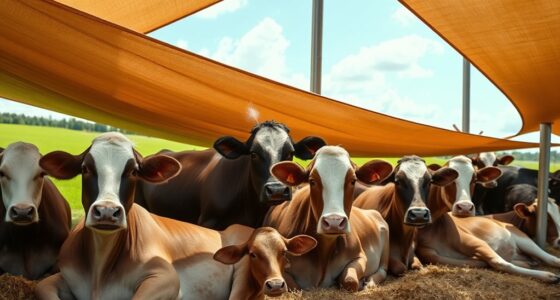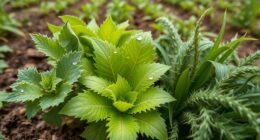Combining goats and sheep can greatly benefit your farm's efficiency and pasture health. Goats thrive on shrubs and woody plants, while sheep prefer short grasses, allowing for complementary grazing. Both species contribute to soil nutrient levels through their manure. Keep in mind their different social structures—sheep stick together, while goats can be more independent. It's vital to manage their health and nutrition effectively. There's much more to explore on how to maximize their compatibility for a thriving farm environment.
Key Takeaways
- Sheep and goats have complementary grazing preferences, enhancing pasture health and land use efficiency when raised together.
- Implement a comprehensive health management plan, including vaccinations and regular health checks, for both species to ensure compatibility.
- Social dynamics differ; sheep prefer stable flocks while goats favor smaller, independent groups, requiring distinct spatial arrangements.
- Diverse pastures support both species' nutritional needs, necessitating pasture rotation and free-choice supplements for optimal health.
- Mixed-species grazing can reduce costs and increase productivity, appealing to various market demands for meat, fiber, and dairy.
Land Use and Grazing Preferences
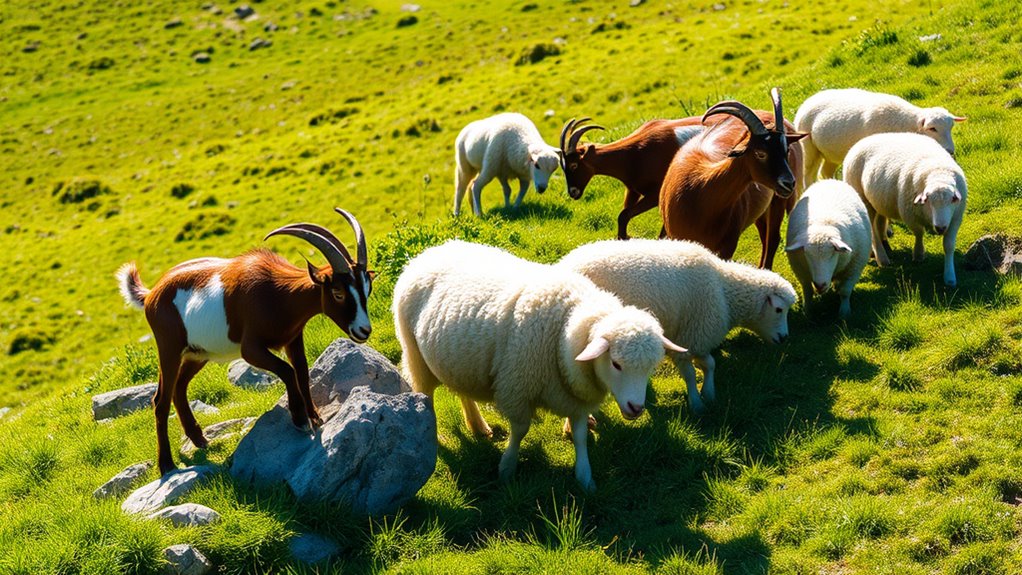
When you integrate sheep and goats into your grazing system, you not only boost land use efficiency but also enhance pasture health.
Their differing grazing habits complement each other perfectly; sheep prefer short grasses and small weeds, while goats thrive on shrubs, woody vines, and tree leaves. This combination allows for diverse pastures, supporting a wider range of plant species.
As they graze together, they help maintain pasture health by reducing overgrazing and controlling invasive plants naturally, cutting down on chemical herbicides.
Additionally, the manure from both species acts as a natural fertilizer, improving soil structure and nutrient availability.
Health and Disease Management
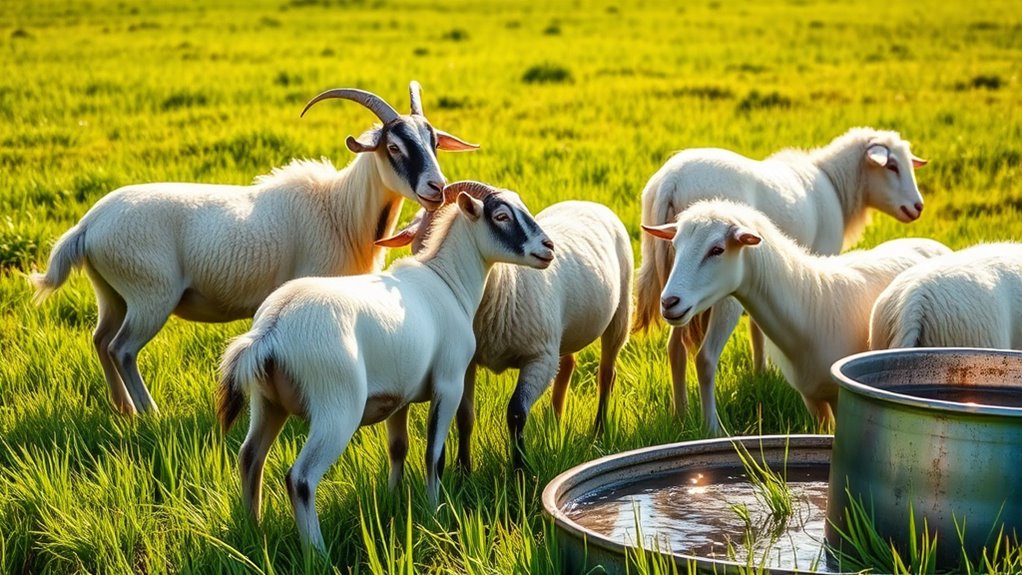
To maintain the health and well-being of your sheep and goats, it's essential to implement a comprehensive disease management plan.
Both species are susceptible to common diseases like clostridial infections and parasites, so vaccinations against these are crucial. Regular deworming helps manage internal parasites such as gastrointestinal worms.
To prevent disease introduction, maintain a closed herd or flock and practice strict biosecurity measures, including quarantining new animals for at least 30 days. Regular health checks allow you to spot issues early.
Focus on sanitation to reduce disease spread and manage footrot through proper care. Collaborate with your veterinarian to create an effective health management strategy tailored to your flock's specific needs.
Social Bonding and Behavior Dynamics

Understanding the social bonding and behavior dynamics between goats and sheep is crucial for their well-being.
Sheep naturally form stable flocks, while goats prefer smaller family units and value their independence. Within their groups, sheep create subgroups that closely follow one another, whereas goats establish a clear hierarchy based on age and horn size.
Both species thrive on companionship but need different spatial arrangements—goats require more room for exploration. They communicate through vocalizations and can recognize familiar faces, enhancing their social interactions.
In terms of threats, sheep stick together, while goats scatter. Recognizing these differences helps you create a harmonious environment, ensuring both species feel secure and fulfilled in their social structures.
Economic Considerations and Market Demand
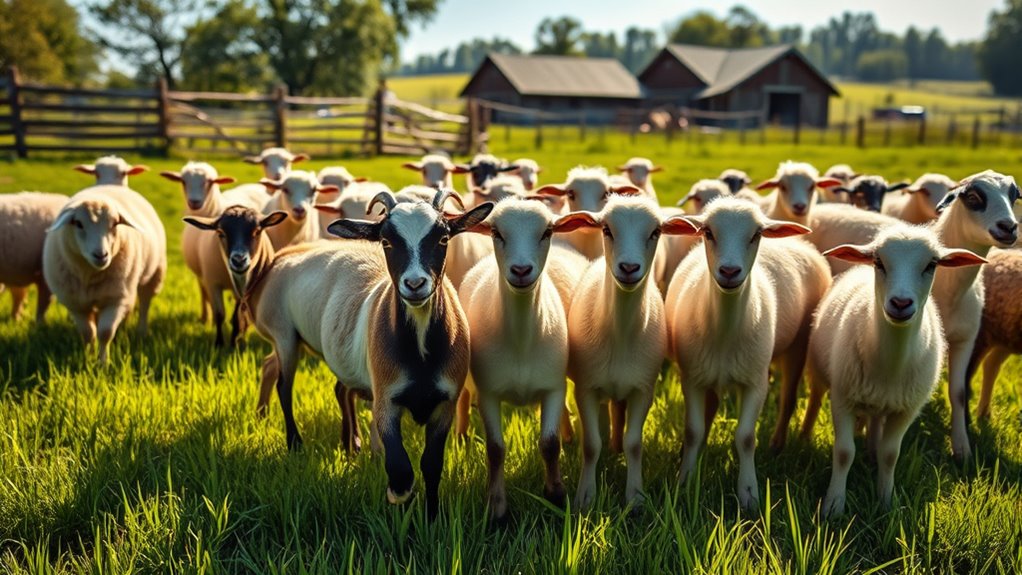
While raising goats and sheep together presents unique challenges, it also offers significant economic advantages that can enhance your farming operation.
Mixed-species grazing boosts productivity by utilizing their different foraging habits, leading to more efficient pasture use. You'll also reduce costs related to pest control and pasture management, thanks to their complementary grazing styles. Additionally, employing best outdoor survival bags can ensure you have essential supplies on hand while managing your livestock in remote areas. Proper management of sheep and goats can further improve their co-habitation and maximize their economic benefits.
This combination allows for diverse income streams, with goats providing meat or dairy and sheep offering fiber or meat. Both animals appeal to specific markets, including ethnic and health-conscious consumers, giving you niche opportunities. Additionally, sustainable foraging can further optimize your livestock's diet and health, contributing to overall farm efficiency.
Nutritional Needs and Feeding Strategies
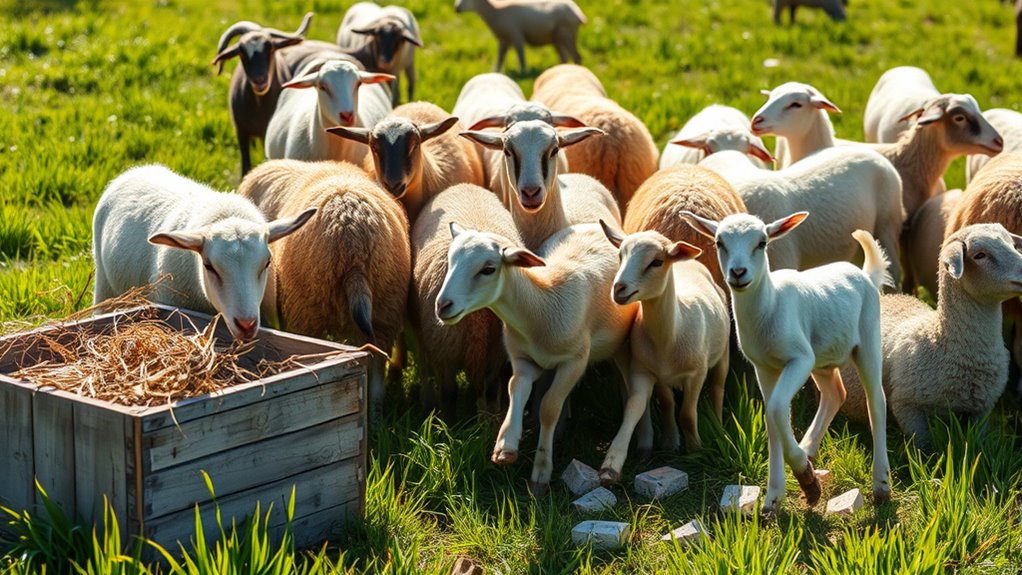
When raising goats and sheep together, meeting their distinct nutritional needs is crucial for maintaining their health and productivity.
Goats, as browsers, prefer woody plants, while sheep, the grazers, favor grasses. To support both, rotate pastures and keep herbage at an adequate height. Provide free-choice hay and, if necessary, grain supplements, especially for lactating or growing animals.
Goats and sheep thrive together when provided with diverse forages, ensuring both species meet their unique dietary needs.
Regularly analyze your forage to ensure a balanced diet. Be mindful of their differing protein and copper requirements, as well as the risks of toxic plants. Gradually change diets to prevent digestive issues, and monitor their health closely to avoid deficiencies.
With proper management, you can create a harmonious environment that meets both species' nutritional needs.
Frequently Asked Questions
Can Goats and Sheep Share the Same Shelter?
Yes, goats and sheep can share the same shelter if you consider their specific needs.
Make sure the shelter has adequate space for both species to avoid competition and stress. Keep feeding areas separate to prevent dietary issues, as goats and sheep have different nutritional requirements.
Ensure proper drainage and insulation for comfort, and provide adequate weather protection to keep them safe from the elements.
Regularly maintain the shelter for the best living conditions.
What Are the Best Breeds for Mixed Grazing?
When considering the best breeds for mixed grazing, you should look at Boer goats for meat production and Spanish goats for their parasite resistance.
Kiko goats thrive in low-input environments, while Merino sheep offer quality wool.
If you prefer fast-growing meat production, Suffolk sheep are a great choice.
Mixing these breeds can optimize your pasture usage, improve land management, and enhance your farm's overall productivity and income potential.
How Do I Introduce Goats to Sheep?
To introduce goats to sheep, start with a gradual approach.
First, ensure your fencing is secure to prevent escapes.
Use a neutral area for their initial meeting to reduce territorial behavior.
Supervise their interactions closely, watching for stress or aggression.
Provide enough space for both animals to feel comfortable and avoid competition.
After the introduction, continue monitoring their health and behavior to address any issues that arise promptly.
What Are the Common Behavioral Issues Between Species?
You might think goats and sheep get along just fine, but they often face common behavioral issues.
Goats can be more aggressive, causing stress in sheep, especially during play or hierarchy establishment. Their need for independence clashes with sheep's social nature, leading to tension.
Additionally, goats' browsing habits might disrupt sheep's grazing patterns, complicating their interactions.
Understanding these differences can help you manage their behaviors and create a harmonious environment for both species.
How Does Weather Affect Goat and Sheep Compatibility?
Weather significantly affects the compatibility between goats and sheep.
You'll notice that both species react differently to extreme heat or cold; goats are more resilient but still need shelter. High humidity increases disease risks for both, so managing their environments is crucial.
Additionally, their differing grazing habits can impact pasture health. If you're not careful with pasture management during adverse weather, you may face overgrazing or nutritional issues, complicating their coexistence.
Conclusion
In conclusion, raising goats and sheep together can be a rewarding endeavor. When you consider their grazing preferences and social behaviors, you'll find they often complement each other surprisingly well. Just like how you might enjoy the company of a friend who balances your personality, these animals can thrive in each other's presence. By managing their health and nutrition wisely, you'll not only maximize your land's potential but also create a harmonious farm environment.



